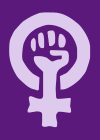Native American feminism
| Part of a series on |
| Indigenous rights |
|---|
| Rights |
| Governmental organizations |
| NGOs and political groups |
| Issues |
| Legal representation |
| Category |
Native American feminism or Native feminism is an intersectional feminist movement rooted in the lived experiences of Native American and First Nations women. As a branch of the broader Indigenous feminism, it similarly prioritizes decolonization, indigenous sovereignty, and the empowerment of indigenous women and girls in the context of Native American and First Nations cultural values and priorities, rather than white, mainstream ones.[1] A central and urgent issue for Native feminists is the Missing and murdered Indigenous women crisis.[2]
Overview
Native feminist Renya K. Ramirez, writes that,
[T]he word Native in the term "Native feminisms" [is used] in order to concentrate on our similar experiences as Native women all over the Americas. But whether one utilizes a tribal name, "indigenous," "Native," "First Nations" or another term, highlighting the heterogeneity is essential for appreciating the varied experiences Indigenous women experience. Indeed, similar to other women of color feminists, this diversity encourages individuals to argue for the development of multiple feminisms rather than a singular feminism.[1]
Ramirez sees a goal of Native feminism as redefining and establishing the struggles of Native women in a field where "feminism" is generally assumed to mean "white feminism".[1] In her view, Native feminism is intersectional, and relationships between race, ethnicity, gender, sexuality, class and nations in North America from colonialism onward are to be reexamined as a means of understanding and identifying feminist praxis.[1]
Native American writer and activist, Paula Gunn Allen has written about Eva Emery Dye's incorporation of Sacagawea into her history of feminism, using the teenage guide as a symbol of strength and power. Allen's opinion, which is not the mainstream of Indigenous scholarship, is that white women's and indigenous women's entanglement goes back to the first European settlers whose lives involved Native neighbors, and with whom they "often shared food, information, child care, and health care".[3]
Cultural baggage associated with the words "feminist" and "feminism" has led to some disagreement about what to call "Native feminism". Kate Shanley, a Native feminist, believes that most Native women see “feminism" as solely a white women's movement, and therefore do not want to be associated with the word.[4] She goes on to say that feminism as a concept, however, by whatever name, has a special meaning to Native women, including the idea of promoting the continuity of tradition, and consequently, pursuing the recognition of Tribal sovereignty.[4][1]
Tribal sovereignty is central to Indigenous feminism, as well a pivotal political concern in Indian country, with Native American self-determination considered foundational to both cultural and material survival.[1] In Ramirez's view, in order to accomplish this, tribal sovereignty must be re-conceptualized from Native women's perspectives.[1]
Crystal Ecohawk writes,
Sovereignty is an active, living process within this knot of human, material and spiritual relationships bound together by mutual responsibilities and obligations. From that knot of relationships is born our histories, our identity, the traditional ways in which we govern ourselves, our beliefs, our relationship to the land, and how we feed, clothe, house and take care of our families, communities and Nations".[5]
See also
References
- 1 2 3 4 5 6 7 Ramirez, Renya K. "Race, Tribal Nation, and Gender: A Native Feminist Approach to Belonging, Meridians, Volume 7, Number 2, (2007), pp. 22-40 Published by Indiana University Press
- ↑ McKenna, Cara (2 Dec 2016). "Indigenous feminists strategize before MMIW inquiry - Advocates in Vancouver to hold last of three public meetings this weekend". Metro Toronto. Retrieved 15 Oct 2017.
- ↑ "Who Is Your Mother? Red Roots of White Feminism | Paula Gunn Allen (1986)". www.historyisaweapon.com. Retrieved 2016-04-05.
- 1 2 Shanley, Kate. 1984. "Thoughts on Indian Feminism." In A Gathering of Spirit: Writing and Art by North American Indian Women, edited by Beth Brant. Rockland, ME: Sinister Wisdom Books.
- ↑ Ecohawk, Crystal, "Reflections on Sovereignty," Indigenous Women 3, No 1 (1999) pp. 21-22
